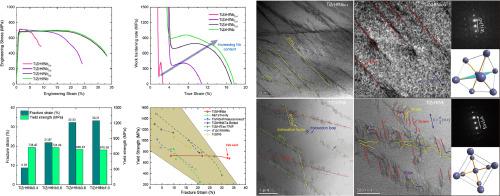Ductilization of single-phase refractory high-entropy alloys via activation of edge dislocation
IF 8.3
1区 材料科学
Q1 MATERIALS SCIENCE, MULTIDISCIPLINARY
引用次数: 0
Abstract
Refractory high entropy alloys (RHEAs) are of particular interest for their superior high-temperature strength. However, most of RHEAs are suffered from the brittleness especially at room temperature which hindered their applications. Here, we choose TiZrHfNbx (x = 0.4, 0.6, 0.8, 1) as a model alloy system in which all the alloys exhibited a single-phase BCC structure. With the increasing Nb content, the fracture strain significantly increased from 8.76 % to 33.21 % without sacrificing the overall yield strength. The dislocation interactions were systematically investigated through extensive experimental and theoretical approaches. The limited tensile ductility of TiZrHfNb0.4 was attributed to the long straight screw dislocations confined in a few slip planes. In sharp contrast, the dislocations in TiZrHfNb alloy are rather homogeneously distributed and the superior tensile ductility of TiZrHfNb alloy is due to the activation of edge dislocations which is rare in ordinary BCC structured alloys. The atomic scale physical origin of different dislocation configuration and behaviors can be attributed to the higher misfit volume and elastic asymmetry of TiZrHfNb alloy. The outcome of this research not only reveal a new ductilization mechanism but also provide a new pathway to design ductile RHEAs through regulation the atomic scale environment.


单相难熔高熵合金边位错活化的延展性
耐火高熵合金(RHEAs)因其优越的高温强度而备受关注。然而,大多数的RHEAs在室温下存在脆性,这阻碍了它们的应用。在这里,我们选择TiZrHfNbx (x=0.4, 0.6, 0.8, 1)作为模型合金体系,其中所有合金都表现为单相BCC结构。随着Nb含量的增加,在不牺牲整体屈服强度的情况下,断裂应变从8.76%显著提高到33.21%。通过广泛的实验和理论方法系统地研究了位错相互作用。TiZrHfNb0.4的拉伸延展性有限是由于长螺旋位错局限于少数滑移面。与之相反,TiZrHfNb合金的位错分布较为均匀,其优异的拉伸延展性是由于边缘位错的激活,而这在普通BCC组织合金中是罕见的。不同位错构型和行为的原子尺度物理根源可归因于TiZrHfNb合金较高的错配体积和弹性不对称性。该研究结果不仅揭示了一种新的延展性机理,而且为通过调节原子尺度环境来设计延性RHEAs提供了新的途径。
本文章由计算机程序翻译,如有差异,请以英文原文为准。
求助全文
约1分钟内获得全文
求助全文
来源期刊

Acta Materialia
工程技术-材料科学:综合
CiteScore
16.10
自引率
8.50%
发文量
801
审稿时长
53 days
期刊介绍:
Acta Materialia serves as a platform for publishing full-length, original papers and commissioned overviews that contribute to a profound understanding of the correlation between the processing, structure, and properties of inorganic materials. The journal seeks papers with high impact potential or those that significantly propel the field forward. The scope includes the atomic and molecular arrangements, chemical and electronic structures, and microstructure of materials, focusing on their mechanical or functional behavior across all length scales, including nanostructures.
 求助内容:
求助内容: 应助结果提醒方式:
应助结果提醒方式:


